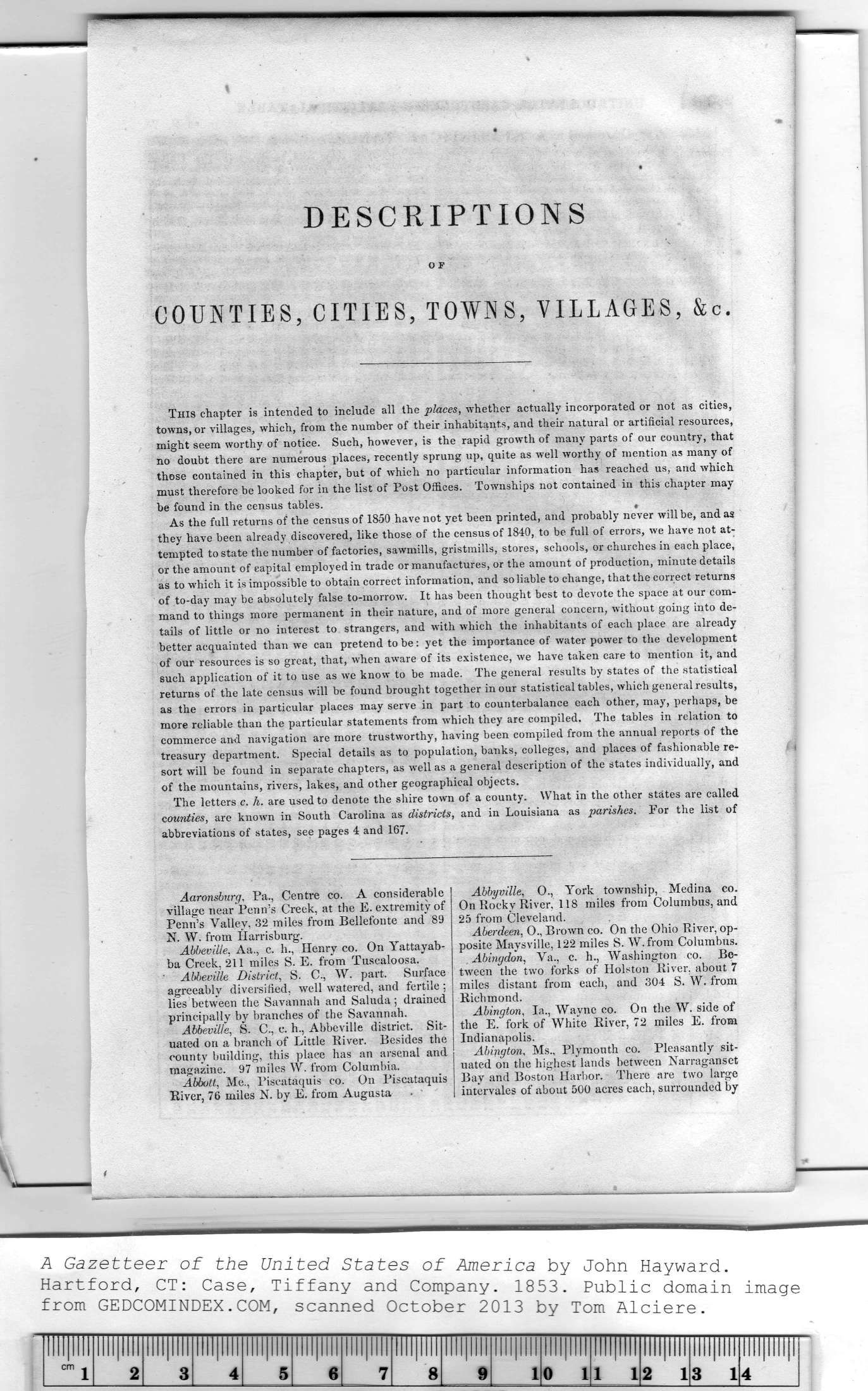|
|
Note: Ctrl and + increases the font size of the text below, Ctrl and - decreases it, and Ctrl and 0 resets it to default size.
DESCRIPTIONS
OF
COUNTIES, CITIES, TOWNS, VILLAGES, &c.
This chapter is intended to include all the places, whether actually incorporated or not as cities,
towns, or villages, which, from the number of their inhabitants, and their natural or artificial resources,
might seem worthy of notice. Such, however, is the rapid growth of many parts of our country, that
no doubt there are numerous plaees, recently sprung up, quite as well worthy of mention as many of
those contained in this chapter, but of which no particular information has reached us, and which
must therefore be looked for in the list of Post Offices. Townships not contained in this chapter may
be found in the census tables. #
As the full returns of the census of 1850 have not yet been printed, and probably never will be, and as
they have been already discovered, like those of the census of 1840, to be full of errors, we have not at-
tempted to state the number of factories, sawmills, gristmills, stores, schools, or churches in each place,
or the amount of capital employed in trade or manufactures, or the amount of production, minute details
as to which it is impossible to obtain correct information, and so liable to change, that the correct returns
of to-day may be absolutely false to-morrow. It has been thought best to devote the space at our com-
mand to things more permanent in their nature, and of more general concern, without going into de-
tails of little or no interest to strangers, and wfith which the inhabitants of each place are already
better acquainted than we can pretend to be: yet the importance of water power to the development
of our resources is so great, that, when aware of its existence, we have taken care to mention it, and
such application of it to use as we know to be made. The general results by states of the statistical
returns of the late census will be found brought together in our statistical tables, which general results,
as the errors in particular places may serve in part to counterbalance each other, may, perhaps, be
more reliable than the particular statements from which they are compiled. The tables in relation to
commerce and navigation are more trustworthy, having been compiled from the annual reports of the
treasury department. Special details as to population, banks, colleges, and places of fashionable re-
sort will be found in separate chapters, as well as a general description of the states individually, and
of the mountains, rivers, lakes, and other geographical objects.
The letters c. h. are used to denote the shire town of a county. What in the other states are called
counties, are known in South Carolina as districts, and in Louisiana as parishes. For the list of
abbreviations of states, see pages 4 and 167.
|
Aaronsburg, Pa., Centre co. A considerable
village near Penn's Creek, at the E. extremity of
Penn's Valley, .32 miles from Bellefonte and 89
N. W. from Harrisburg.
Abbeville, Aa., c. h., Henry co. On Yattayab-
ba Creek, 211 miles S. E. from Tuscaloosa.
Abbeville District, S. C., W. part. Surface
agreeably diversified, well watered, and fertile;
lies between the Savannah and Saluda ; drained
principally by branches of the Savannah.
AbbeviUe, S. C., c. h., Abbeville district. Sit-
uated on a branch of Little River. Besides the
county building, this place has an arsenal and
magazine, 97 miles W. from Columbia.
Abbott, Me., Piscataquis co. On Piscataquis
River, 76 miles N. by E. from Augusta
(
Abbyville, 0., York township, Medina co.
On Rocky River, 118 miles from Columbus, and
25 from Cleveland.
Aberdeen, 0., Brown co. On the Ohio River, op-
posite Mavsville, 122 miles S. W.from Columbus.
Abingdon, Va., c. h., Washington co. Be-
tween the two forks of Holston River, about 7
miles distant from each, and 304 S. W. from
Richmond.
Abington, la., Wayne co. On the W. side of
the E. fork of White River, 72 miles E. from
Indianapolis.
Abington, Ms., Plymouth co. Pleasantly sit-
uated on the highest lands between Narragansct
Bay and Boston Harbor. There are two large
intervales of about 500 acres each, surrounded by | |
|

